1.
This part of Rajasthan is a land of superlatives and machismo; it is the Texas of India.
Jaisal built a golden city in the desert by erecting a massive fort on top of a rock. It thrived along the Silk Road. Unsurprisingly, he called it Jaisalmer.

Jodh responded by building an even bigger fort on top of the rock near his town. And it was known as Jodhpur. He also let the Brahmins paint their houses indigo, hence the town is now known as the Blue City.


A few hundred kilometers away, Jai decided that he would not be outdone. He build a palace beneath a fort nestled amongst hills crisscrossed with fortified walls and then built another palace in a lake. Unsatisfied, he decided to build a whole new city - arrayed along grid lines - with a palace at its center and then painted the whole thing pink. In keeping with the theme, Jaipur is known as the pink city.
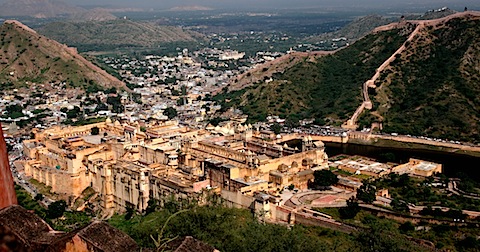

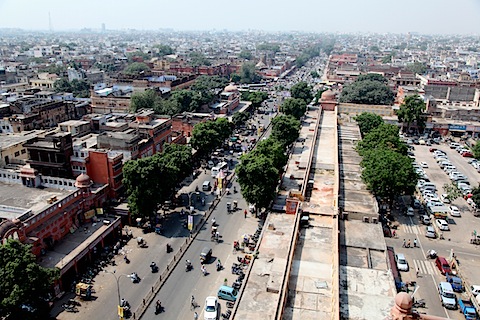
When not erecting monuments to themselves, the kings of these different city states would attack one another over petty grievances. For instance, raiding each others' caravans, snubbing one another's invitations to meal and therefore laying siege to cities, etc. The usual contrivances of small principalities.
With Independence they were all forced into one state which was called Rajasthan as it is the land (stan) of kings (raj). Nowadays there are still Maharajahs, but they no longer command armies and audiences. To attack one another they use the major tool at their disposal: the audio guides to their respective forts.
When you tour the different fort/palace complexes it's advisable to get the audio guides as there tends to be minimal signage. Each tour explodes with hyperbole about how the carvings/gates/walls/howdahs/palanquins/weapons/warriors/etc. of that palace are the most ornate/strongest/most beautiful/biggest/fiercest/etc. in the world.
There are interviews with the Maharajahs plus the CEOs and Senior Lead Researchers of various charities and foundations (people here are obsessed with rank and titles) tossing you pearls of wisdom about the pomp and prestige of the each fort.
A slightly revisionist history has been written where there are only brave warriors and the forts are unconquered (ignoring that several times the forts fell when guards were bribed). The Rajput kings are now unbeaten - but what's left unsaid is that the Mughals coerced them into siding with them, understanding that they never needed to beat them to control them (the British then did exactly the same thing again).
Moreover, we hear about how strong and wise some of the Maharajahs were. For instance, there's one of Jaipur's Maharajahs who was made a brigadier general (or something similar) by the Brits in World War II. What's not mentioned is that he was 22 years old and surely this could not have been for political purposes (I'm sure it was due to his Rajput attitude of "death before defeat" as is frequently repeated in the audio guides).
In all sincerity, the guides are great and they walk you through breathtakingly complex structures with hundreds of years of history. They could just use a little humility (for more on this theme, see the section below on the Commonwealth Games).
2.
Wendy is extremely popular in this part of India. Witness the following:
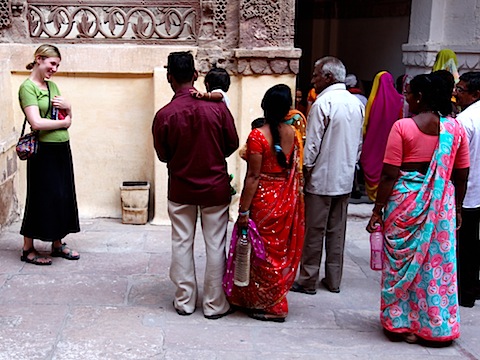
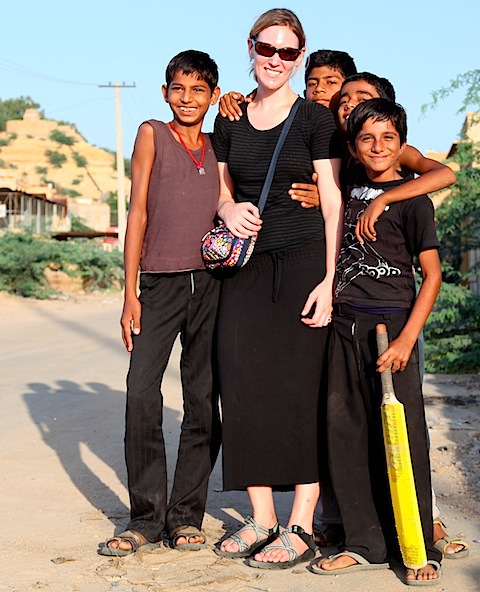

Everywhere we go, people want to have their photo taken with her. It's cute.
Less cute is when boys want to have their photo taken with her and then paw her/try to kiss her/etc. That's when my blood boils and we call a halt to it.
Equally less cute are the stares that she (and me, but more her than me) gets as we walk around. Hardcore leering: men stop work and stare at her. Boys on motorcycles gaze unblinkingly. When we sit in restaurants she has to turn her back to the crowd.
Sometimes if I stare back at these yokels they'll stop but frequently they just don't seem to care. The irony is that if I stared at their wives or daughters like that they'd probably come after me with a knife.
But it would be impossible for me to stare at their wives or sisters because they're all practicing pardapratha - or parda (pronounced per-dah) for short. This is a tradition - imported to appease the Mughal overlords - that states that all women (and we're talking predominantly Hindus here) should cover their face with a veil to protect them from the leering glances of men. There's an even more conservative interpretation that insists that women should not go outside.
As a result, you see a disproportionate number of men on the street and rarely intermingled groups of women and men. In villages you never see women at all (unless they're collecting children, searching for firewood or drawing water while men sit around smoking, chewing paan or drinking chai).
The whole damn culture is built around segregating women from (and keeping them below) men. When you visit the beautiful Meherangarh fort at Jodhpur, you learn that the beautiful carved courtyards were created entirely so that women could look out from behind a screen (jali) and not be seen by the men below.

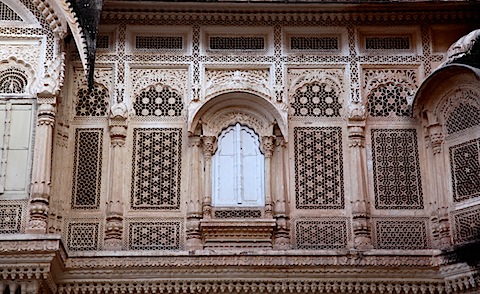
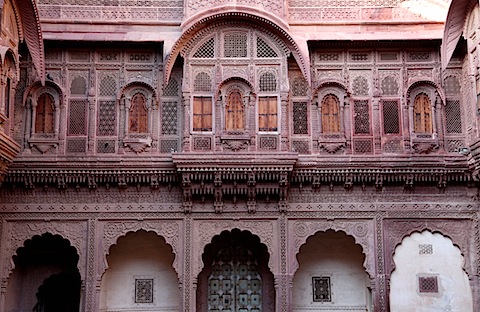
Ditto with a whole wing of the Amber (near Jaipur) palace where only women were allowed. The Maharajah wasn't even allowed in and eunuchs sent messages from him to his harem and back. In fact, the only royal woman allowed out was the mother of the current Maharajah; the rest had to stay inside (I can only imagine the politics this created within his harem; the quest to have your son become designated heir must have taken on a whole new meaning...).
(More royal nonsense: in Jaisalmer and Jodhpur, when the Maharajah died, his wives were expected to walk into his funeral pyre. This tradition was finally snuffed out in 1834 or so).
Parda, a purely cultural and not at all religious tradition, has survived the decline of the Mughal empire and shows only a few signs of abating. In the cities you see younger people of both sexes intermingling, but it's the exception, not the rule.
In fact, this conservatism has trickled into many other aspects of life here. For instance, I have not seen a single woman driving a car. I could be in Saudi Arabia.
I've only seen two women wearing an outfit that revealed their shoulders. Both were young women who were obviously from a city (big sunglasses and skinny jeans). I haven't seen one woman wearing an outfit that shows her calfs. A further irony is that the men are encouraged to show more skin: Bollywood actors have made the sleeveless vest a popular look for muscular men.
An interesting aspect of this conservatism is that it's only come about in the past few hundred years (I'll guess its perfectly correlated with that Muslim invasion). When you visit any number of the ancient Hindu temples around the country you can't help but be struck by the early Indian love of the full bodied, scantily clad, big breasted woman. There are statues to them everywhere.
In other temples you also witness couples carved in erotic poses from the kama sutra. And there are numerous paintings of bare breasts and shoulder in paintings depicting scenes from the Ramayana and other sacred Hindu texts; only in the more recent versions do wobbly bits get covered up.
3.
Being close to the Pakistani border, this is one of the most heavily militarized zones in the country. As you criss-cross the state you pass numerous garrisons, each proudly displaying their division's name: Desert Foxes, Lightning Lancers, Prancing Prancers (okay, I make that last one up).
And, in case you weren't sure about it, the enemy is Pakistan. Outside Jodhpur we drove by one military base and perched before it was the half-destroyed fuselage of a 70's era fighter plane; the Pakistani flag is still visible on the rear wing.
In Jaisalmer, you're constantly reminded of the nearby presence of Pakistan. The airport is run by the military and while there's technically a commercial flight out of there, it hasn't run in ages (although you can confound yourself trying to book it on Kingfisher Airways' website). And given the number of military jets performing maneuvers there, the risk of a commercial jet getting too close to the border is probably just too high (especially as these nuclear enemies are only about 30 seconds away from each other by missile; Russia and the U.S. were nine minutes).
Interestingly, the flights appear to be under radio silence. We would sit on the roof of our hotel under the blazing sun, with the smell of raw sewage occasionally wafting over us (this just randomly happens in India), and watch the jets scream in to land. Once we saw a flare rocket up from the ground and the incoming plane broke right; three minutes later he came back and made the landing. I'm guessing the runway wasn't ready and the only way to signal it, sans radio, was to fire the flare.
4.
Jaisalmer is also probably the only city I know of where you can still get a stone house build. And it's not just any stone house either: it's going to be sandstone carved into some of the most ornate screens and details you can imagine. These are some of the best stone masons in the world:

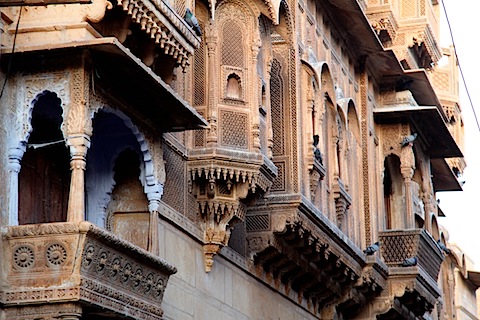
Like all things, there's no such thing as a free lunch. The downside here is that there are open sewers and the streets are lined with cows and boar (the dark spot beside the cow) to dispose of garbage:
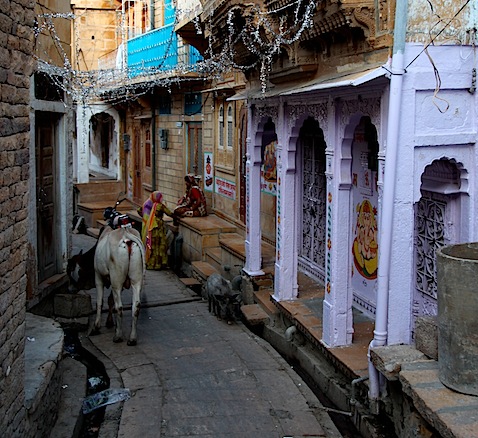
5.
Wendy and I went on a one day camel safari. It would be better described as a two hour camel ride followed by a night on a charpoy (webbed bed)in the desert, but that doesn't sound quite as romantic.
In was a great time. The sun in the Thar Desert is stupefyingly hot plus the desert is more scrub than sand dunes (they appear intermittently), so anything beyond two hours would frankly get a little repetitive. You'd feel like you were seeing the same thing over and over again. You'd want a break from the monotony of the repeating scenery. You...
More importantly, Wendy got to ride a camel; her second favourite animal after elephants. Our camels were incongruously named "Lucky" and "Babluji"; I can't remember who had which:
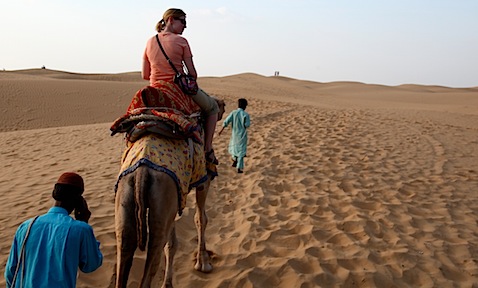
The scene above shows two of the overwhelming contradictions that you find in India.
The first is that Ali, my camel driver, is able to talk on his cellphone in the middle of the desert. It's amazing how wired this country is (and they don't even have 3G networks yet; can't wait to see what happens when that occurs); everyone is connected.
The second is that Ali's nephew Salim is leading Wendy's camel when he should really be in school.
When I think of child labour I think of Dickensian factories with little hands for little places and it all takes place behind closed doors. I know that some of that exists here, but a lot of the 12-60 million child labourers (gov't vs. 3rd party numbers) here are doing much more mundane things. Washing cups at a juice stand. Updating inventory at a store. Carrying water or maybe just leading camels.
At first you think they're just helping out part time but when you go back the next day and they're still there you realize that this is their life. It's scary how banal child labour is here.
In this charming scene straight out of the 20th century - BC, not AD that is - this son is helping his father out blacksmithing:
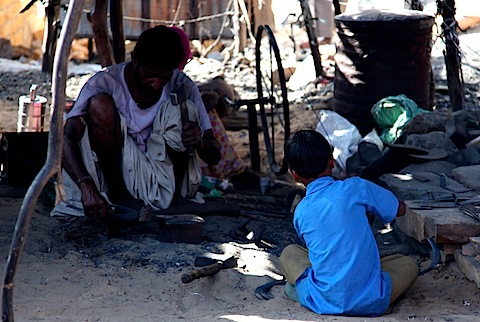
Okay, I pulled a cheap shot with the photo above (although I stick with my statement that the blacksmithing techniques are the same as those used 4,000 years ago). This kid is actually in his school uniform. He's actually a symbol of one of the truly great features of India: society's incredible drive to educate their youth. He'll almost certainly never work as a blacksmith and hopefully won't work outside at all.
It's heartwarming to see the quest for education in this country. As you walk the street of any town or read any magazine you are bombarded with ads to learn how to program, to get an MBA, to become an engineer. (In fact, the most common ads seem to be for cell phone carriers, cement and advanced degree programs)

If you've ever taken a subway in New York or any other North American city you've also been bombarded with education ads. However, they're for online associate degrees to become nurse assistants or medical billers; they're low value training offered by scam universities.
I can't speak to the quality of the education being offered here (but India has some of the finest universities in the world; witness the IIT's), but the sheer scale of it and the focus on the higher end of the value chain is awe inspiring. I can only imagine what it's going to be like here in 20 years when the country is teeming with highly trained people trying to solve all the complex problems India - and the world - faces.
These guys have a great future:
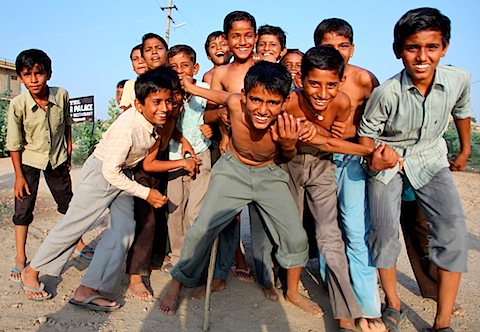
6.
One of the things you have to come to terms with when you travel in India is that, unless you're buying railway or airplane tickets, there is not a single listed price in this country. And even if someone does show you that elusive listed price, it, like everything else, is negotiable.
Moreover, you are a walking ATM. Your mere presence as a tourist makes you a mark: everyone is going to try and rip you off. In fact, it's almost perfect game theory: you're unlikely to ever do another transaction with anyone you meet here so they're going to try and extract the single highest price they can get from you at that very instant.
This means you should expect any of the following to happen:
- You go to a fort. There are rickshaws outside and you ask the price back to your hotel. It is IDR 250. You offer IDR 100. You are then told how these are reserved rickshaws and therefore cost so much more. Threaten to walk away and you get it for IDR 100.
- You call a hotel. They quote you a price that is way north of what is in your guide book. You quote the guide book. They offer you a 10% discount; now only 40% more! You reply with "I'll pay \<book price>" and they say no. You say "okay, I'll go elsewhere" and they cave.
- You want a driver. You go to the government tourist office and they show you how it costs x/km and you're going to have to pay 2x that as the driver needs to come back. You quote the price you're willing to pay (~1/2-1/3 less). The tourist officer tells you how he knows a few people who don't work for the government and maybe they could get you a price below the government rate; you end up paying almost what you wanted
You'll notice a common theme here as to what to do: threaten to walk away. In a country of over a billion people there are thousands of other people within arms reach who will happily sell you the same service for a lower price.
Another common experience you'll have: people will follow you around trying to extort money from you. A common modus operandi is that you walk into a fort/palace/etc. and someone starts following you around. You say "thanks, but I don't need a guide" and they say "oh sir, I'm not a guide; I just want to make sure you see a few things."
At this point, you have two options:
- Tell them you'd like to just walk around by yourself
- Get ready to listen to sob stories: "I don't make much money"; "My father is old and I am responsible for my family"; "I need to get a gift for my girlfriend." It never stops
A similar approach is followed by some touts. They come up to you and start to engage you in pleasant conversation that it would be rude for you to shut down e.g., "where are you from". This is followed up by a compliment to you: "you look like a Bollywood star", "you take nice photos". All of this is buttering you up for the ask: "why don't you come by my shop".
They're using the law of reciprocity (doing something positive to you in order to make you feel like you're indebted to them) in order to guilt you into their shop, etc. You've just got to be firm in letting them know that they can talk to you but that under absolutely no circumstances will you go in their shop/give them money/etc. It's also fine to request you be left alone for your own privacy.
There are a lot of other tricks people use to try and get your money. At forts, the ticket issuers take extra long giving you your change, hoping that you'll forget it and walk away; they even post signs telling you that if you don't check your change before leaving the wicket, you're out of luck. Not only will your admission price be 4-20X an Indian, you'll also need to pay an additional camera fee.
If you have a driver, when you reach your destination, your driver will ask for more money saying that he miscalculated the rate (and this is after he picked a restaurant where you'd be overcharged so that he would eat for free). Drivers, in fact, are particularly stubborn: we've had a few who have tried to negotiate toll rates on the highways.
You've got to be in the mood to handle these things or you're going to go insane.
Also, remember that none of it is personal.
We've had fierce negotiations over rickshaw prices (usually over $1; hey, it's principle) where the driver is trying to make me feel like I am pulling food out of the mouths of his starving kids. Minutes later we're in his rickshaw (usually at our price) and he's asking us where we're from, telling us how his family is so happy, etc.
It's like we've never met before...
7.
From the above, you might gather that I don't enjoy being in India. Not at all.
Rather, India is a place where you have to learn to balance two exactly opposite ideas in your head. You're going to love what you see and experience. Unless you are paying a small fortune or traveling with a local, the process of getting to experience it is going to be awful. Zen, zen, zen...
Here are some snapshots of various great things we've seen recently. All were worth it:


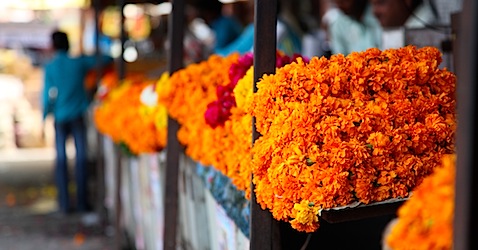
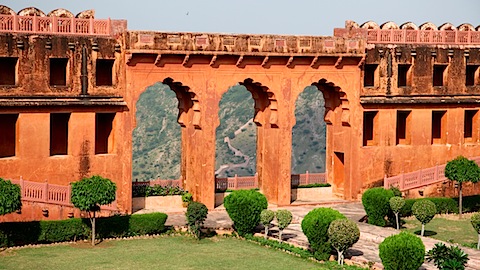

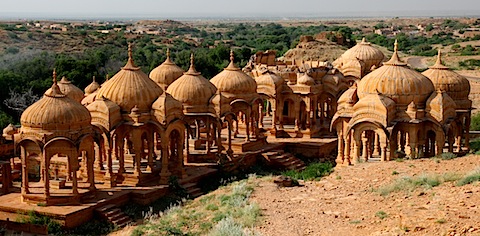
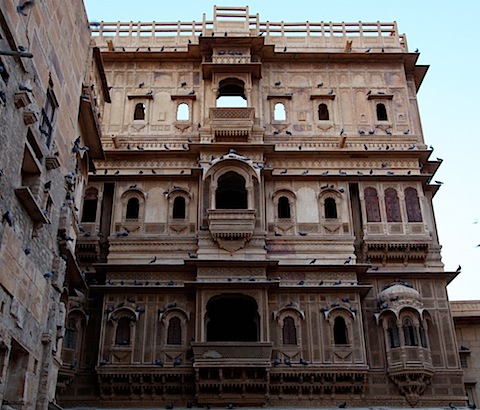

8.
Jaipur has some pretty stupid traffic, but it's manageable:
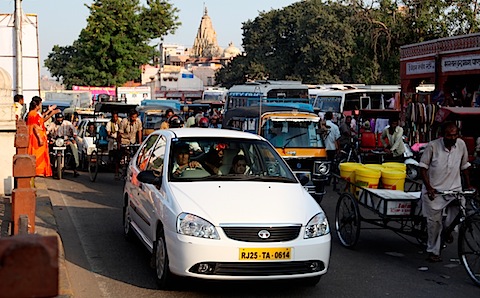
As you struggle to cross the road (note the local above throwing her arms up in exasperation), you can play traffic bingo by trying to count all the different forms of transports: motorcycles, bicycles, tricycles, auto rickshaws, bicycle rickshaws, cars, trucks, buses, tractors and camels:
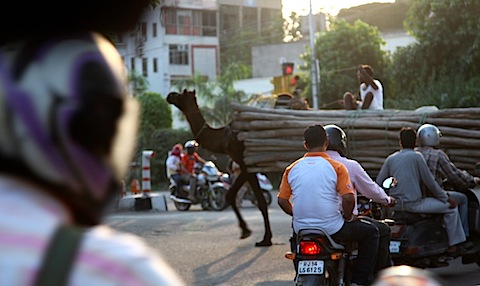
Less fun is the traffic we faced getting to Jaipur. We had a driver for the 11 and a half, 600 km drive from Jaisalmer and we spent the last few hours of it on a three lane highway at night.
This was one of the most terrifying experiences of my life. The road was choked with overstuffed trucks whose unrestrained diesel emissions cast a pallor of the apocalypse over the highway. Many of the trucks lacked rear lighting and would just suddenly appear on the road ahead. This, combined with an arbitrariness of both their lane choice and decisions as to when to switch lanes, gave me the feeling that I was in a space ship flying through an asteroid belt.
Our driver brought this sensation to life by slaloming between these trucks. Sometimes he'd tag team with another car and we'd pass on the left while our wingman took the right. You had to be careful in the left lane (the curb side; opposite side of the road here) as it contained the odd slow-moving tractor or camel cart or someone randomly entering the highway and coming up to speed, all the while hidden from view by the endless slew of trucks.
Wendy prayed to the winged goddess of alcohol to come down and kiss her lips with her sweet nectar. I thought of how I'd tell this story assuming we got through it all...
9.
Newsflash: India is hosting the Commonwealth Games (pop quiz: who hosted the last one? Answer: I have no idea. I think it might have been Edmonton or Singapore)
The games almost didn't happen because India did such a bad job organizing them. Bridges were falling down. Roofs were collapsing. Wild dogs were fouling the unfinished athlete's village. Some countries almost pulled out; Britain ended up putting up their athletes in a hotel.
But the games are on! And it's a big deal here. I don't think India has ever hosted an event this big and they're indignant at the success of Beijing 2008 and the current Shanghai world's fair.
The opening ceremonies were last night (when I wrote this) and today India's 200 channel television universe is chatting incessantly about it.
In fact, the reportage is unabashedly, navel-gazingly hagiographic. Words fail to describe the ridiculousness of the "coverage". Check out these photos of the "news":
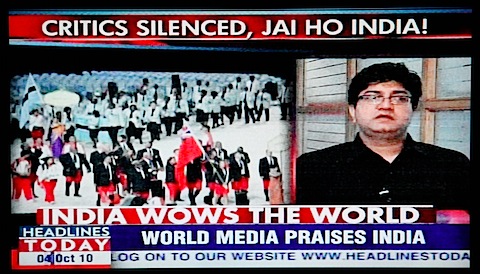

In case you can't make that out, the sentence is "World media bows to truly shining India". Living in the U.S. I got used to over the top new coverage (Hello CNBC!), but this is a whole new dimension approaching nationalist propaganda.
And come on India: "truly shining" countries don't have to tell themselves that they're "truly shining". They just are.
10.
Obligatory food notes.
Verdict: still excellent.
Check out this tandoor platter from the kitchen at the Umaid Bhawan hotel (crazy hotel: if Liberace was an Indian hotelier, he would have built it) in Jaipur. The tandoor platter is three types of grilled chicken and two types of grilled mutton. My mouth waters at the memory:

A gatta curry is a local specialty. It consists of steamed gram flour dough dumplings in spicy yoghurt gravy:

I'm also crushing on the murgh malai tikka; it's like chicken tikka but marinated in yoghurt. This one's from Saffron in Jaisalmer (and that's a cucumber transmuted into a candle):
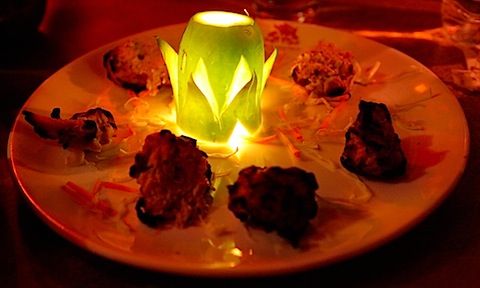
They're all outdone by the incredible kebab stand at Handi in Jaipur:
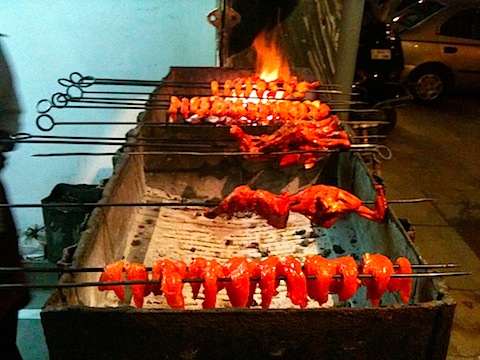
I'm going to have to buy a tandoor when I get back to Canada...